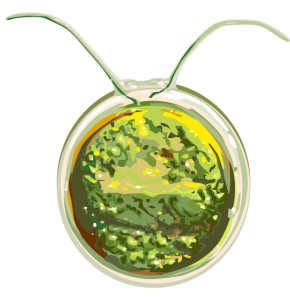<{% seo %}>

I am broadly interested in the process of genetic adaptation during environmental change.
I combine bioinformatics, molecular biology, and experimental evolution to understand how environmental stressors, selection, mutation, and recombination contribute to evolution.
I use the model organism Chlamydomonas reinhardtii, which is a unicellular green alga, to investigate my following main research interests:

The rate and effects of new mutations have important consequences for the health and fitness of organisms. Genetic variation generated via mutation forms the raw material on which natural selection acts and hence is the basis of evolutionary adaptation. However, at any point in time, only a subset of all spontaneous mutations that have arisen in a population persist, as most are lost or fixed by drift and selection. Therefore, the patterns of variation we observe in populations and the genetic basis of adaptations are influenced not only by selection but by the spectrum of mutational types introduced.
My goal is to understand how the rate and pattern of mutation accumulation interacts with environmental stressors and selection. To do this I have been characterising the genome-wide distribution and spectrum of all new mutations in C. reinhardtii that fixed during selection in stressful NaCl concentrations relative to expectations from spontaneous mutations in a benign environment.
An individual might be able to turn on or off some genes in order to better tolerate new conditions, a process called phenotypic plasticity. This inducible response may evolve through mutations in regulatory regions of the genome or through epigenetic changes. Epigenetic changes are modifications that are not encoded directly in the DNA or RNA. By modifying gene expression, they play a role in stress responses, and traits such as flowering time and primary root length.
To study the evolution of phenotypic plasticity during adaptation we can characterise reaction norms at the phenotypic level, and gene expression at the molecular level. In 2010, I created a long-term evolution experiment with C. reinhardtii where I regularly increased the concentration of salt in the water. Over 98% of my experimental lines went extinct over the course of the experiment. Today, 10 lines are still alive and thriving in seawater-level salinity. I have shown using reaction norms that the 10 surviving lines adaptated to increasing salinity through changes to both the constitutive and inducible tolerance to salt. This is consistent with selection acting on both structural and regulatory regions of the genome.
To characterise the evolution of phenotypic plasticity at the molecular level, I am currently sequencing the RNA of ancestral and salt-adapted lines grown in low and high salinities. My goals are to profile the transcriptome of ancestral and evolved lines in order to characterise the contribution of phenotypic plasticity to adaptation to high salinity, and link the transcriptome to the genome in order to asses the role of genetic and epigenetic changes to the evolution of plasticity.

How sex evolved and why it is maintained are two of the most fundamental questions in evolutionary biology. Sex has many disadvantages, yet the majority of eukaryotes are sexual. It is thought that the advantage of sex lies in recombination and its ability to indirectly increase the rate of adaptation in changing environments by generating novel combination of beneficial alleles or by freeing beneficial alleles from inferior genetic backgrounds.
C. reinhardtii is a facultative sexual organism. I can easily manipulate the reproductive cycle such as to have strictly asexual or sexual populations. I am interested in how sex and recombination affect the probablity of extinction during environmental change, the rate of adaptation, the repeatability of evolution, and evolution in the genome.

The extent to which evolution is repeatable has important implications. If evolution is highly repeatable, the trajectories and outcomes of evolution in different lineages will always be the same. On the other hand, if evolution is not repeatable, then trajectories and outcomes will be diverse. Thus, the repeatability of evolution affects our understanding of the nature of biodiversity and can inform the extent to which evolutionary theory can be used to make predictions. The repeatability of evolution depends on the relative contribution of selection, chance, and history.
To determine what factors affect the importance of chance and history during evolution, I propagated replicated populations of C. reinhardtii in controlled environments. I measured the change in fitness after a few hundred generations and determined how much variation had arisen among replicate populations and among populations with different histories. I applied a similar approach to study the importance of history in extinctions, and measured rates of extinction in populations with different histories.



